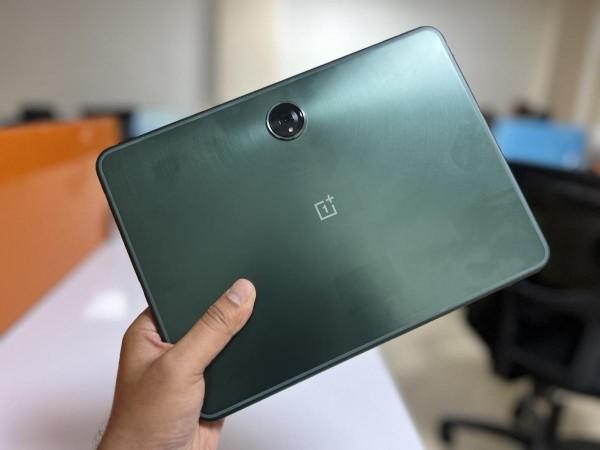OnePlus finally launched its first-ever tablet, dubbed OnePlus Pad, in February alongside the OnePlus 11-series. After briefly getting our hands on the tablet at the event, we now finally get to spend some time with it and put it through our routine tests to see how well it fares in the new space.
Though OnePlus is a household name in the smartphone industry, it stayed clear of the tablet space up until now. But the brand's delayed entry didn't seem to have dented its popularity. After years of hype and rumours, when OnePlus Pad finally made its way, a wave of excitement took over fans and consumers. Starting at Rs 37,999, the Halo Green OnePlus Tab is a gorgeous-looking tablet with its unique elements, the most unique aspect being its 7:5 aspect ratio. Usually, tablets are 16:10, 16:9 aspect ratio and 4:3 in some cases. This one defies the trend and comes close to what iPad offers.
But that's just one of the things that set the OnePlus Pad apart. Here are our observations based on our experience with the tablet.
Note: OnePlus sent over the OnePlus Pad alongside the OnePlus Magnetic Keyboard and a stylus. The tablet runs OxygenOS 13.1 and it is the higher-end version with 12GB RAM and 256GB storage, which costs Rs 39,999.
Design and display
OnePlus Tab is carefully designed to cater to users' multiple needs. It's not too big, nor too small. It's a mid-size tablet, which offers plenty of screen real-estate for all things-tablet in a compact form factor. The sleek design makes it easy to handle and the aluminium alloy construction gives it a premium touch.

On the back, the tablet has a circular brushed finish with a circular camera module, housing a single lens and an LED flash, which complements the overall look of the tablet. There's also a OnePlus logo at the centre of the tablet and an antenna line outlining the back panel. The tablet's dimensions, 258 x 189.4 x 6.5mm, make it perfect for single-hand use in portrait orientation.
On the display side, there's a flat 11.61-inch LCD panel with 2,800x2,000 pixels and up to 144Hz refresh rate. Though LCD doesn't match the quality of OLED or LED panels, the display is bright enough and outputs vibrant and punchy picture quality. The decision to go with LCD is a natural course to keep the price in check and you'll be thanking for it when you've to replace the display.

In our day-to-day use, the display offered smooth transitions with good colour reproduction. The pictures appeared crisp and vibrant, suitable for viewing multimedia content and gaming. While using the tablet, one important detail we noticed, and were thankful for, was how the weight distribution is done with excellent precision. This helped in using the tablet with ease while on the go.
The top left corner of the tablet has the physical buttons, power button on the left side and the volume controls on the top left. The USB Type-C port is on the right and magnetic contact points for the keyboard at the bottom. What's kept away from the visual glance is the magnetic connect point at the top edge, which holds your stylus.

On both sides of the tablet are two speakers, which have Dolby Atoms support along with OnePlus' Omni-bearing Sound Field technology. Both worked wonders in our daily usage.

OnePlus Pad can get really, really loud and with clarity. The way the speakers are placed on the sides, it's rare that you'll block them while holding the tablet. When using the tablet in portrait orientation, OnePlus technology adjusts the left and right audio channels to deliver that consistent audio performance. Though we noticed a dip, in most cases, you'll find it more than sufficient.

Everything is placed on the OnePlus Pad so thoughtfully, once you get used to it, there's no going back.
Performance

OnePlus Pad is powered by Dimensity 9000 processor clocking at 3.05GHz. OnePlus continues its "never settle" mantra here and delivers the optimum performance one can expect from OnePlus. It's not often we see tablets unleashing the power of performance, but the OnePlus Pad is right for both work and play. It handles tasks, such as browsing the Internet, running multiple apps, documenting articles and notes, reading, playing games, watching multimedia content and letting kids do their homework, with absolute ease. We did not run into any issues or glitches, rather it came in handy for both our use and kids' screen time. Multitasking was handled well on the 12GB RAM model, though in some cases, the apps in the background memory would fall asleep.

On the software front, there's OxygenOS 13 running the show and it does an excellent job on many fronts. For instance, the UI is snappy and responsive, the Limelight feature in video calling works well, multi-window support puts the screen real estate to best use and more. The gestures, like swiping down two fingers to split screen work like a Harry Potter wand.

The software is clean and worked well for the most part. But accessory support could use some refinement. OnePlus sent us the whole package, the keyboard cover and stylus, which we tested extensively during our review. Firstly, things we loved about the keyboard is the ease of typing despite not being a full-size keyboard and having solid feedback.

The quality of the keyboard case is really good, adding durability and ease of carrying around with the assurance that the tablet won't slip. But all that quality product is not backed by consistent Android support. Since the keyboard is priced at Rs 7,999, it's only fitting to mention that it doesn't come with back-lit keys and the trackpad is tiny. Both accessories fall short when compared to the likes of Samsung or Apple, which are more refined and offer practical productivity use. We mainly used the keyboard cover for typing and no shortcuts. The stylus has a good level of precision, but again not as good as Apple Pencil. And it costs Rs 4,999. The stylus was a bit on the smoother side for our taste, so if you're an artist, you'll find those strokes going further than intended.

Overall, OnePlus Pad makes for a mean performance machine and you can do without its accessories unless OnePlus finds a way to patch things up via software updates.
Camera use-cases
OnePlus Pad has a 13MP rear camera with LED flash. We didn't go out chasing the sunsets with this, it's not what we recommend either. But we found the 13MP sensor more than capable in our productivity use cases, like scanning documents and clicking some urgent pictures sans high-def quality. But what we loved most is the selfie camera, which may just be 8MP, but its placement makes it more than ideal for video conferencing. The camera takes the centre spot on top of the longer side of the tablet, so you'll be in the centre during video calls. The limelight feature comes to rescue as it maintains framing remarkably well.

Buy or nay!
OnePlus Pad is the ideal multimedia machine. We thoroughly enjoyed watching content on that big, beautiful display backed by its fantastic audio setup. The aspect ratio makes it usable in both landscape and portrait orientation, much like an iPad. The performance is refined and the software backs it up well. Though there are some shortcomings on the accessories front, we see no reason why OnePlus Pad cannot be in the top-3 tablet recommendations under Rs 40K.
OnePlus Pad is an excellent tablet, but it's not perfect just yet. Unless you have an iPhone or Samsung phone, OnePlus Pad can be the go-to choice for you.
Pros
- Great display
- Excellent design and form-factor
- Performance par excellence
- Lasting battery
- Best sounding tablet
Cons
- Accessories need to level up
- Falls short on some software fronts when compared to iPad
- Accidental touches all too often
- Needs more apps to put the stylus to better use
- No microSD card














